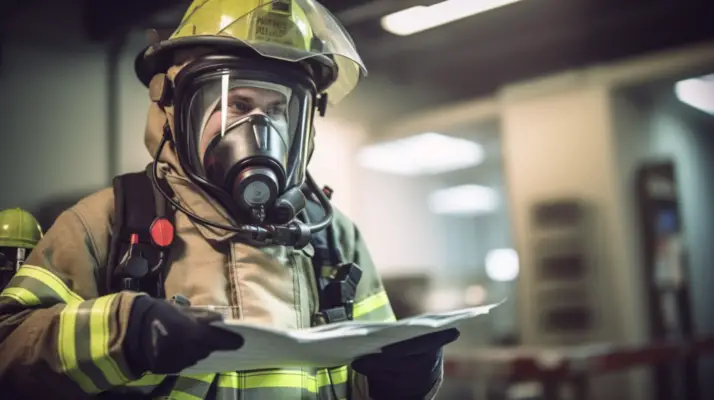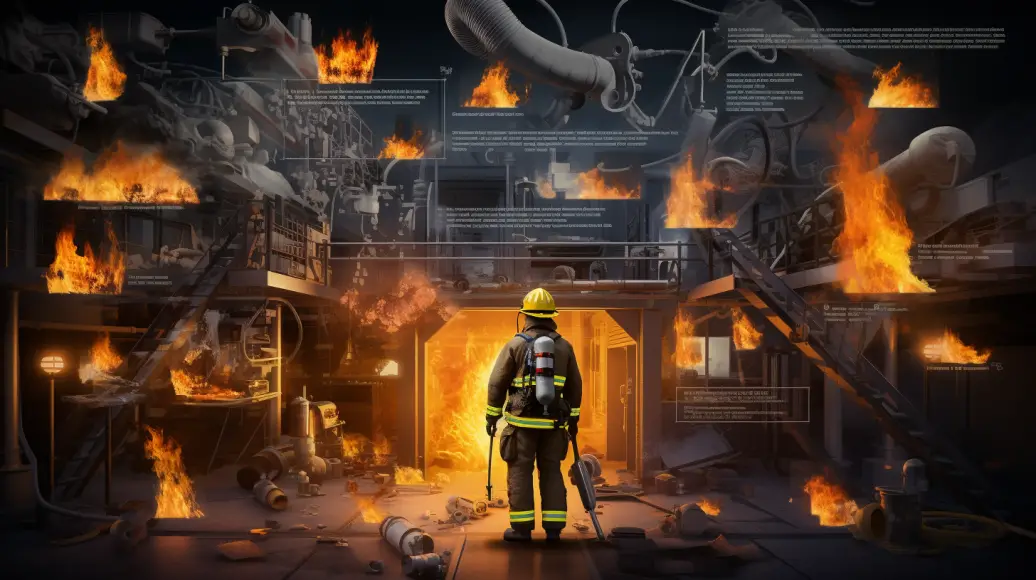Fire risk assessment plays a critical role in ensuring the safety of individuals and properties by identifying potential fire hazards, evaluating their likelihood of occurrence, and implementing appropriate control measures.
This systematic process involves thoroughly examining buildings, structures, and activities to determine the risk posed by fire. Conducting a risk assessment involves following certain procedures and complying with legal guidelines and regulations. Its objective is to avoid fires or reduce their potential impact.
This article provides a comprehensive overview of the definition of fire risk assessment. It outlines the importance of this practice in safeguarding lives and assets, emphasizing its objective nature.
The steps involved in conducting a fire risk assessment are discussed in detail, highlighting the need for meticulousness and organization throughout the process.
Additionally, this article explores the numerous benefits of conducting the assessment, such as enhanced safety awareness and compliance with legal obligations.
Finally, practical tips are provided to assist professionals in effectively carrying out this vital task.

Importance of Fire Risk Assessment
The importance of these risk assessments lies in their ability to provide a comprehensive evaluation of potential fire hazards within a given environment, allowing for the implementation of effective preventive measures and the development of appropriate emergency response plans.
The fire risk assessment process involves the following:
- Identifying potential sources of ignition.
- Assessing the materials present that may fuel a fire.
- Evaluating containment measures such as fire doors and sprinkler systems.
- Considering the means of escape for occupants.
Through a thorough analysis of various factors, a risk assessment can pinpoint areas of weakness and provide recommendations to decrease the risks identified.
A key tool in this process is a fire risk assessment checklist, ensuring all necessary aspects are considered and documented.
This approach helps organizations proactively manage fire risks and protect people and property from potential harm or damage.
Steps Involved in Fire Risk Assessment
One of the initial stages in evaluating the potential for fire hazards is to conduct a comprehensive analysis of the surrounding environment. This process involves a systematic approach to identifying and assessing potential fire risks within a given area.
The fire risk assessment process typically follows a methodology that includes several key steps:
- Identification of potential ignition sources: This step involves identifying any potential ignition sources that could start a fire.
- Evaluation of fuel sources: Here, the focus is on assessing the availability and characteristics of combustible materials that could fuel a fire.
- Assessment of fire spread potential: This step involves analyzing how the fire might spread within the environment under consideration.
- Identification of vulnerable elements: The aim here is to identify any elements or features within the environment that may be particularly susceptible to damage or destruction by fire.
- Determination of control measures: This step involves recommending appropriate measures to minimize or eliminate identified risks.
It is imperative to follow this structured approach, as these risk assessments offer valuable insights into areas where preventative measures can be implemented to effectively reduce the likelihood and impact of fires.
Benefits of Conducting a Fire Risk Assessment
Conducting a thorough analysis of the surrounding environment allows for a comprehensive understanding of potential fire hazards, enabling informed decisions on preventive measures.
A fire risk assessment provides numerous benefits and advantages to individuals and organizations. Firstly, it helps identify and prioritize areas with the greatest risk, allowing for targeted mitigation strategies.
The likelihood of a fire occurring can be significantly reduced by implementing appropriate control measures, such as installing smoke detectors or fire suppression systems.
Additionally, conducting regular assessments ensures compliance with legal requirements and industry standards, minimizing liability and potential financial losses.
Moreover, a well-executed fire risk assessment enhances safety awareness among employees or residents, fostering a culture of preparedness and reducing panic in emergencies.
Investing time and resources into conducting a fire risk assessment yields long-term benefits by safeguarding lives, property, and reputation.
| Benefit | Advantage |
|---|---|
| Targeted mitigation | Legal compliance |
| Enhanced safety | Reduced panic |
| Long-term protection |
Legal Requirements and Regulations
Legal requirements and regulations dictate the necessary measures to ensure compliance with fire safety standards.
These regulations outline specific guidelines for conducting a fire risk assessment, which is crucial in identifying potential fire hazards and implementing appropriate control measures.
Fire risk assessment compliance involves adhering to these regulations and ensuring that all aspects of the assessment are carried out effectively. This includes identifying fire hazards, evaluating the risk associated with each hazard, and implementing suitable control measures to mitigate these risks.
Additionally, fire risk assessment documentation is vital in complying with legal requirements.
It provides evidence that a thorough evaluation has been conducted and appropriate actions have been taken to minimize the potential for fires and protect individuals’ safety within a given premises or environment.

Tips for Conducting an Effective Fire Risk Assessment
An effective fire risk assessment involves carefully examining the environment, identifying potential hazards that could compromise safety, and implementing appropriate control measures to mitigate these risks.
The fire risk assessment process typically begins with a thorough inspection of the premises to identify any potential sources of ignition or fuel that could contribute to a fire. This includes evaluating electrical systems, heating equipment, and flammable materials.
Additionally, it is crucial to assess the layout and design of the building to identify any potential escape routes or barriers that may hinder evacuation in case of a fire.
Common fire hazards often assessed include faulty wiring, improper storage of flammable substances, inadequate ventilation systems, and blocked emergency exits.
Taking the time to conduct a thorough fire risk assessment and addressing any identified hazards can greatly decrease the chances of a fire happening and enhance the safety of the surroundings.
Frequently Asked Questions
How often should fire risk assessments be conducted?
Fire risk assessments should be conducted regularly to ensure the safety of individuals and property.
The frequency of these assessments depends on various factors, such as the type of building, its occupancy, and any changes in the environment that may affect fire risks.
What are the consequences of not conducting a fire risk assessment?
Neglecting fire risk assessment can result in severe consequences such as increased likelihood of fires, property damage, injuries, and loss of life. Regular assessments are important to identify and mitigate potential hazards.
What common fire hazards should be considered during a fire risk assessment?
During a fire risk assessment, common fire hazards that should be considered include faulty electrical systems, flammable materials, inadequate fire suppression measures, improper storage of combustible substances, and lack of fire safety training.
Fire prevention and fire safety are essential in addressing these hazards.
Are any specific industries or sectors exempt from conducting fire risk assessments?
Exempt industries from conducting fire risk assessments may vary depending on legal requirements. Certain sectors, such as small offices or low-risk retail establishments, might be exempt if they meet specific criteria outlined in fire safety regulations and legislation.
How can technology be utilized to enhance the effectiveness of fire risk assessments?
Technology advancements, such as virtual reality simulations, can enhance the effectiveness of fire risk assessments. These simulations provide realistic scenarios for training and evaluating responses to fire emergencies, improving preparedness and identifying potential risks in a controlled environment.

Conclusion
In conclusion, conducting a fire risk assessment is of utmost importance in ensuring the safety and protection of individuals and properties from the devastating effects of fires.
By following this process, organizations can identify potential fire hazards, evaluate their risks, and implement appropriate mitigation control measures.
This not only helps to prevent fires but also ensures compliance with legal requirements and regulations.
An effective fire risk assessment is crucial for maintaining a safe environment and reducing the likelihood of fire-related incidents.

Chris Ekai is a Risk Management expert with over 10 years of experience in the field. He has a Master’s(MSc) degree in Risk Management from University of Portsmouth and is a CPA and Finance professional. He currently works as a Content Manager at Risk Publishing, writing about Enterprise Risk Management, Business Continuity Management and Project Management.

